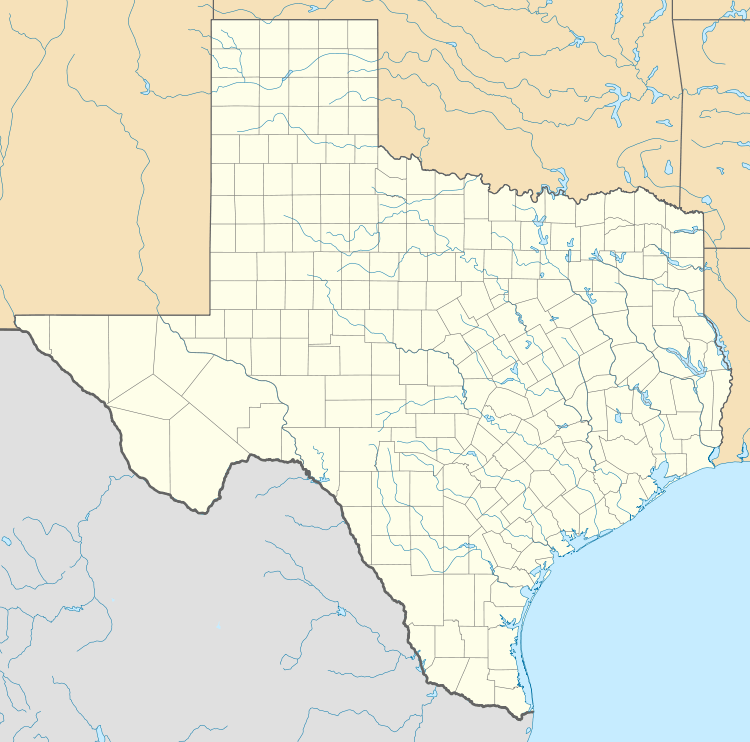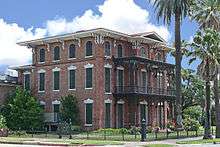Ashton Villa
|
Ashton Villa | |
 | |
  | |
| Location | 2328 Broadway St, Galveston, Galveston County, Texas, United States |
|---|---|
| Coordinates | 29°17′59″N 94°47′33″W / 29.29972°N 94.79250°WCoordinates: 29°17′59″N 94°47′33″W / 29.29972°N 94.79250°W |
| Area | 16,500 square feet (1,530 m2) |
| Built | 1859 |
| Architect | James Moreau Brown |
| Architectural style |
Victorian Italianate |
| NRHP Reference # | 69000204[1] |
| RTHL # | 9924 |
| Significant dates | |
| Added to NRHP | October 28, 1969 |
| Designated RTHL | 1967 |

Ashton Villa is a fully restored, historic home located on the corner of 24th and Broadway in Galveston, Texas, United States. Constructed in 1859, it was one of the first brick structures in Texas.[2][3]
History
On January 7, 1859, Colonel James Moreau Brown, a prominent hardware merchant and banker, purchased four lots at the corner of 24th and Broadway in Galveston, on which to build a home. Referencing architectural pattern books current at the time, he modified several plans to design his future home. Using slave labor and skilled European craftsmen, Brown proceeded to build one of the first brick structures in Texas.[2][4]
The three-story house was built in Victorian Italianate style, with deep eaves, long windows and ornate verandas that were topped by lintels made of cast iron. The brick walls were made thirteen inches thick, to help protect against humidity and add strength to the structure. The interior of the home was laid out and designed around a central hall floor plan. Brown's wife, Rebecca Ashton, named the home in honor of one of her ancestors, Lt. Isaac Ashton, a hero in the U.S. Revolutionary War.[2][4]
Civil War
The house was completed in 1861. When the American Civil War began, the home became the headquarters for the Confederate Army and served in that capacity for the entire war, except for a brief period in the fall of 1862. In the fall of 1862, Galveston was surrendered to the Union Army, who made Ashton Villa their headquarters. The Union's occupation was short lived, however, as Galveston was re-taken by the Confederates during the Battle of Galveston in January 1863.[3]
Fall of the confederacy
On June 19, 1865, Union General Gordon Granger and 2,000 federal troops arrived in Galveston, Texas, to take possession of the state and enforce the emancipation of its slaves. While standing on the balcony of Ashton Villa, Granger read the contents of “General Order No. 3”:
The people of Texas are informed that, in accordance with a proclamation from the Executive of the United States, all slaves are free. This involves an absolute equality of personal rights and rights of property between former masters and slaves, and the connection heretofore existing between them becomes that between employer and hired labor. The freedmen are advised to remain quietly at their present homes and work for wages. They are informed that they will not be allowed to collect at military posts and that they will not be supported in idleness either there or elsewhere.[5]
Juneteenth
June 19 has since become known as Juneteenth, a portmanteau of the words June and nineteenth.
Former slaves in Galveston rejoiced in the streets with jubilant celebrations. Juneteenth celebrations began in Texas the following year.[5] Across many parts of Texas, freed people pooled their funds to purchase land specifically for their communities’ increasingly large Juneteenth gatherings — including Houston’s Emancipation Park, Mexia’s Booker T. Washington Park, and Emancipation Park in Austin.[5]
1900 storm
Brown died in 1895, just five years before the 1900 hurricane devastated Galveston. However the house, with its thick brick walls, managed to withstand the storm's winds and infamous storm surge, while serving as shelter to Brown's widow and children. In the storm's aftermath and grade raising of the city, its basement was filled in with sand, and the surrounding grounds were topped with two feet of soil.[2]
Recent
The home was sold in 1927 to the El Mina Shrine masonic order. Making very little changes to the building, the house served as their business offices and meeting hall until 1970, at which point it was put up for sale.[2][4] Under the threat of demolition, the Galveston Historical Foundation raised $125,000 to purchase Ashton Villa. With additional funding from local foundations and the government, the process of restoring and refurnishing home began. Much of the original furniture and art was able to be retrieved, and the decision was made to open the home as a House Museum. On July 25, 1974, the Galveston Historical Foundation opened the home to the public to serve as a House Museum, visitors center and a place for special functions.[3][4]
Receiving more than 18 inches of water during Hurricane Ike, the first floor is recently restored. The Villa is not open for public tours, but the first floor is available for rental.
Ashton Villa is listed on the National Register of Historic Places and is a recorded Texas Historic Landmark.[6]
References
- ↑ National Park Service (2007-01-23). "National Register Information System". National Register of Historic Places. National Park Service.
- 1 2 3 4 5 Judy D. Schiebel. "ASHTON VILLA". Texas State Historical Society: Handbook of Texas. Retrieved 2010-05-15.
- 1 2 3 "Ashton Villa". National Park Service. Retrieved 2010-05-15.
- 1 2 3 4 "1859 Ashton Villa". Galveston Historical Foundation. Retrieved 2010-05-15.
- 1 2 3 "Juneteenth". State of Texas website. Archived from the original on 18 July 2006. Retrieved 2006-07-06.
- ↑ "Ashton Villa--South and West Texas". A National Register of Historic Places Travel Itinerary, US National Park Service. Retrieved 2009-10-03.
External links
| Wikimedia Commons has media related to Ashton Villa. |
- Official website — Ashton Villa.

